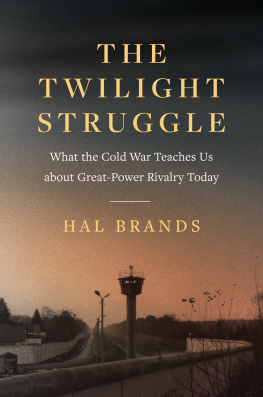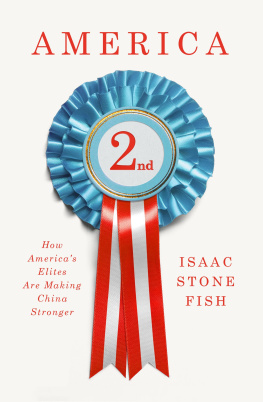Stronger
Stronger
Adapting Americas China Strategy in an Age of Competitive Interdependence
Ryan Hass

Published with assistance from the Mary Cady Tew Memorial Fund.
Copyright 2021 by Ryan Hass.
All rights reserved.
This book may not be reproduced, in whole or in part, including illustrations, in any form (beyond that copying permitted by Sections 107 and 108 of the U.S. Copyright Law and except by reviewers for the public press), without written permission from the publishers.
Yale University Press books may be purchased in quantity for educational, business, or promotional use. For information, please e-mail
(U.K. office).
Set in Janson Roman type by Integrated Publishing Solutions.
Library of Congress Control Number: 2020946716
ISBN 978-0-300-25125-8 (hardcover : alk. paper)
A catalogue record for this book is available from the British Library.
This paper meets the requirements of ANSI/NISO Z39.48-1992 (Permanence of Paper).
Contents
ONE
Americas Enduring Strengths
TWO
Chinas Strategic Ambitions
THREE
Competitive Interdependence
FOUR
Technology Competition
FIVE
Mitigating Risks of Conflict
SIX
Navigating Great Power Relations
SEVEN
Moving Forward
Acknowledgments
As a proud father of four, I am familiar with the term it takes a village to raise children. I now understand that the phrase applies to writing a book as well. For this project, I am indebted to many mentors, colleagues, and friends.
In this book, I seek to reflect lessons drawn from observing President Barack Obamas intellectual rigor in internal policy debates on China, as well as his clear and forthright approach to dealing with difficult challenges with Chinese leaders. The book also is informed by my good fortune in having access toand extended conversations withcentral participants in the American policy-making process. I am deeply grateful to Susan Rice for including me in her thinking, planning, and travels on issues relating to China. I feel fortunate to have had many opportunities to join masters of their craft in their engagements with Chinese counterparts, including Bill Burns, John Kerry, Tony Blinken, Avril Haines, Jon Huntsman, and Gary Locke. I owe a debt of gratitude to Evan Medeiros for hiring me to join the National Security Council staff and to Dan Kritenbrink for demonstrating what can be accomplished through grit, force of will, kindness, and diplomatic acumen. I learned a lotand had a lot of funworking alongside Susan Thornton, Abe Denmark, and Dave Stilwell on China policy. None of my experiences dealing with China would have been possible without Tom Christensen and Ford Hart shoehorning me into a political reporting officer position in the Embassy of the United States, Beijing, many moons ago. I also am indebted to countless scholars and officials in the United States and China who enlightened me about aspects of the bilateral relationship but are not willing or able to be acknowledged by name.
My work here is an attempt to build on the foundations that have been laid by many people I am fortunate to call mentors. Among the many mentors who have informed my views, few stand out more than Jeff Bader, Ken Lieberthal, J. Stapleton Roy, Doug Paal, Tom Christensen, and Bob Goldberg. Although they all bring their own style to their dealings with Chinese counterparts, they all are brutally effective in eliciting information and emphasizing their views with Chinese interlocutors.
No book is the product of a single individuals work. I appreciate the advice and assistance I received in both research and refinement. I benefited from a richness of research support for various aspects of the book, including from Kevin Dong, James Haynes, Zach Balin, Rachel Lambert, and Sarah Ko. Brookings scholar Bruce Jones did more than anyone to make it possible for me to write this book. Two Brookings senior fellows, Cheng Li and Richard Bush, provided valuable guidance at every step in the process. Brookings director of research in foreign policy Michael OHanlon offered tremendous advice and perspective on all aspects of the book. Kevin Nealer, principal in the Scowcroft Group, helped me ground my thinking in practical reality and made the process of doing so a lot of fun. My agent, Bridget Matzie, made an idea a reality with her brash clarity on what needed to be done. The team at Yale University Press was remarkably helpful. It included Jaya Chatterjee, Eva Skewes, Mary Pasti, Sonia Shannon, Aldo Cupo, and Dustin Kilgore.
Most importantly, I thank my wife, Meredith Sumpter, and my children, Helen, Reed, Byron, and Henry, for their unquestioning support. Embarking on this project would not have been possible without them. They are the anchor of my world, the loves of my life, and the ones to whom I dedicate this book.
Introduction
The United States and China stand today at the greatest inflection point in their relations since they established diplomatic ties in 1979. Neither side feels satisfied with the current relationship. Washington and Beijing both seek to revise how each side relates to the other and how both countries relate to the rest of the world. A broadly continuous U.S. policy orientation of the last several decades that seeks to deliver a blend of cooperation and competitionwith a focus on maximizing the former and managing the latter so as to prevent escalation to conflicthas come to feel unsatisfactory to many Americans. Such dissatisfactions have become more charged as anger has built over losses in lives and economic opportunities resulting from COVID-19, a pandemic that originated in China and that a segment of the American population blames Chinese authorities for not doing a better job of halting. The U.S.-China relationship has come to be defined by overheated rhetoric, simmering antagonism, and intense distrust. President Trump and others have convinced many Americans that they are being disadvantaged by a flawed relationship that favors China at the expense of the United States.
The rising heat around China in the United States has real-world implications. In addition to foreclosing any capacity for U.S.-China coordination on shared threats, rising antagonism is fueling a sense of urgency in Washington to blunt Chinas rise. The United States has launched sweeping unilateral tariffs against China, triggering a predictable retaliatory response from Beijing. Even as we have seen a truce on escalation in the trade war at the time of this writing, the two nations have made no progress in resolving any of the structural sources of tension in the trade relationship. China continues to distort global markets with preferential treatment for its own firms. Meanwhile, technological competition is steadily intensifying as both countries seek to limit their own vulnerabilities while also working to dull the other sides comparative advantages. The United States has tightened export controls to limit sales of high-tech products to Chinese firms, and China has sought to gain advantage over the United States in setting global standards.
Americas efforts to weaken China are harming itself. Two years of the trade war forced the United States Treasury to spend $28 billion in farm subsidies to partially offset the losses to the American agricultural sector. By point of comparison, this amount is twice what America spent a decade earlier to bail out its auto industry during the great recession. The financial costs will not be limited to the $28 billion, though. China has likely been permanently lost as a reliable agricultural export market for American growers. Outside of agriculture, major American corporations such as Apple and Ford have cited China trade tensions as striking blows to their bottom lines. Boeing has not sold a single plane to China since the trade war began. These firms are far from alone, though, since S&P 500 firms derive on average between one-third and one-half of their profits from China. Major American semiconductor and chip makers have warned that they will need to slash their own research and development budgets if they can no longer generate revenue from sales to China. Partly to hedge against these risks, a number of American high-tech firms have begun offshoring research and development so as to avoid
Next page








